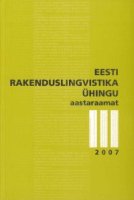Ametikeele oskuse mõõtmine: tekst ja ülesanne eesti keele kui teise keele kuulamistestis
Measuring specific purpose language ability: texts and tasks in Estonian as a second language listening tests
Author(s): Ülle Türk, Tiina KikerpillSubject(s): Language and Literature Studies
Published by: Eesti Rakenduslingvistika Ühing (ERÜ)
Keywords: Estonian as a second language; language tests; development and assessment of listening comprehension
Summary/Abstract: Although tests of Estonian as a Second Language have been developed for more than ten years, most of them have been designed to test learners’ competence in general Estonian. Testing of Estonian for specific purposes has been neglected so far. The EU Phare Project of 2004-2005 “Developing the Estonian language competence in vocational schools with the language of tuition other than Estonian” offered a welcome opportunity to develop ten different listening tests for students of ten specialities. The article discusses the process of test development focusing on different models of language competence and the characteristics of specific purpose language ability, various aspects of listening comprehension, features of spoken texts and the principles that need to be followed when transforming written texts into spoken ones, principles of choosing appropriate task types and the general procedure for developing listening tests. The test development process highlighted a number of issues. One of the major obstacles to designing good listening tests turned out to be a lack of appropriate oral texts. Therefore, it was necessary to use some written texts and adapt them bearing in mind the differences between the spoken and written languages. In designing the tasks, the skills used in real-life listening to the same types of texts were taken into account and an attempt was made to tap similar skills. To minimize the test method effect, each test employed at least two different task types. As the number of students who took each test was very small, it is not possible to analyse the results statistically and to draw any reliable generalizations from them. It was clear, however, that students found it easier to answer the questions asking for specific information than those obliging them to obtain information from various parts of the text and combine it in a new way. Similarly, familiar task types proved to be easier than those that had not been used in Estonian language examinations before.
Journal: Eesti Rakenduslingvistika Ühingu aastaraamat
- Issue Year: 2007
- Issue No: 3
- Page Range: 177-191
- Page Count: 15
- Language: Estonian

